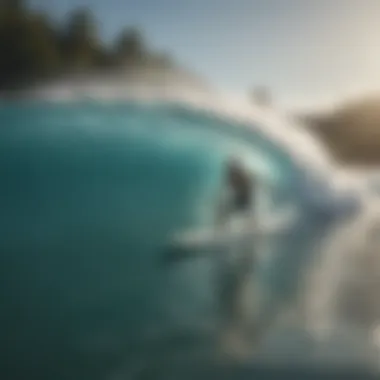Exploring Surfboarding Culture and Community


Intro
Surfboarding has woven itself into the very fabric of coastal culture. It's more than just a pastime; it’s a lifestyle that resonates deeply with the rhythm of the waves and the spirit of adventure. Whether you're a novice with stars in your eyes or an experienced-waterman navigating the sharks, this article aims to unpack the essence of surfboarding. We'll venture into the techniques that define this dynamic sport, break down the critical equipment you’ll need, and explore the environmental consciousness that pervades the surf community. So, grab your favorite board, and let's dive into the ocean of surfboarding culture.
Surfboarding Techniques
Beginner Tips for Mastering the Basics
For those who are just dipping their toes into the surf, mastering the fundamentals is key. Learning to paddle, position yourself on the board, and eventually pop up to ride the waves are the cornerstones of surfboarding.
- Paddling: Start by lying flat on your board. Keep your body centered and use smooth strokes with your arms. Remember, it's not just about strength; technique is crucial.
- Positioning: Adjust your body so that your hips are aligned with the tail of the board. This helps with balance and prepares you for the ride ahead.
- Popping Up: When you feel the wave lifting you, perform a quick, fluid motion to shift from lying down to standing. Your hands should push off the board just behind your shoulders, and your feet should land shoulder-width apart.
To make practice less daunting, try finding a gentle, forgiving wave to start with. That way, you'll spend more time riding the wave and less time wiping out.
Advanced Techniques for Seasoned Surfers
Once you’ve conquered the basics, it’s time to refine your skills and adopt advanced techniques that add flair to your style. These can also help you take on bigger challenges.
- Carving: This maneuver involves turning sharply on the wave's face to create dynamic s-turns. It’ll require keen body awareness and balance.
- Cutbacks: Engage in a quick pivot on the board to ride back toward the breaking wave. It’s a stunning skill that showcases your ability to read the wave.
- Aerials: When you're feeling adventurous, try launching off the lip of the wave for a brief moment of flight before landing back. Be sure to stay grounded while landing to maintain control.
Each of these techniques demands practice. Don’t rush the process; mastery takes time and consistency.
Surfboard Equipment
Reviews of the Latest Surfboards on the Market
Selecting the right surfboard can make or break your surfing experience. The surfboard comes in various shapes and sizes, tailored for distinct styles and conditions. Here are a few notable models making waves in 2023:
- Mid-Length Boards: Offering a perfect blend between short and long boards, models like the Strider Mid provide versatility for various conditions.
- Shortboards: High-performance boards such as the Ultra Pro focus on speed and agility, ideal for those chasing the thrill.
- Longboards: For a more laid-back vibe, the Glide Classic gives you the nostalgia and style of traditional surfing, perfect for cruising.
Read thorough reviews on sites such as Britannica or relevant surf forums on Reddit to get insights and user experiences.
Essential Gear for Every Surfboarder
Aside from a good board, certain equipment is essential for any surfboarding venture. Components that every surfer should consider packing include:
- Wetsuit: Investing in a high-quality wetsuit can keep you warm in cooler waters. Thickness varies with water temp, so choose accordingly.
- Leash: Always attach a leash to your board. This keeps it close and prevents it from becoming a safety hazard in the water.
- Surf Wax: A little wax goes a long way. Apply it to enhance grip on your board, especially in those fun and slippery moments.
"The best surfer out there is the one having the most fun."
— Phil Edwards
Fostering a diverse set of skills and ensuring you have the right gear can elevate your surfing game. As we explore through the pages of this surfboarding culture, remember that knowledge and practice go hand in hand. So let’s paddle forward into the ocean of insights awaiting us.
Understanding Real Watersports
When we think about real watersports, surfboarding emerges as more than just a recreational activity; it encapsulates a vibrant culture and an intricate lifestyle intertwined with nature. The waves beckon enthusiasts, not merely to ride them, but to understand the underlying currents of community, environment, and skill. This topic serves as the backbone of our article by providing critical insight into how surfboarding has evolved, its profound cultural significance, and how it addresses contemporary concerns surrounding environmental conservation.
Definition and Scope
Surfboarding, at its core, involves gliding over waves while standing on a surfboard. However, there’s a world of difference between simply paddling out and truly embracing the surf lifestyle. This definition not only encompasses the physical act but also the gear, the techniques, and the ethos that binds surfers. The sport is often viewed through various lenses—be it the competitive spirit found in contests like the World Surf League or the laid-back vibes of a local surf shanty.
The scope of surfboarding goes beyond the ocean; it intertwines culture, art, and sustainable living. It builds bridges between surfers from elite competition to those just dipping their toes in for the first time. Unlike many other sports, surfboarding embraces an all-encompassing community—the camaraderie, shared experiences, and the respect for the ocean connects individuals worldwide.
The Evolution of Surfboarding
Surfboarding did not emerge overnight. Its roots stretch back to ancient Polynesian cultures, where riding waves was woven into the social fabric. Early surfer King Kamehameha, for instance, highlighted how cultural practices were shaped around surfboarding in Hawaii. Over time, surfboarding has morphed into a multifaceted sport. The wooden boards of yesteryears have transformed into sleek, lightweight compositions, emphasizing speed and agility.
Throughout the late 20th century, surfboarding witnessed revolutionary changes, particularly in the shape and design of surfboards, which catered to various styles—from shortboards made for tricks in the air to longboards favored for their steadiness and ease for leisurely rides. These transformations were not just about performance; they reflected changing values within the surf community, showcasing the importance of innovation while maintaining a bond with tradition.
As we navigate through this article, we will delve into these transformational moments—how they influenced surf culture and the surfers themselves. By understanding where surfboarding comes from, we may better appreciate its complexities today, making room for an enriched experience both on and off the waves.
The Cultural Significance of Surfboarding
Surfboarding extends beyond a mere sport; it embodies a lifestyle that finds its roots deeply entangled in culture and community. The waves whisper tales of adventure while surfers express their identity through the art of riding them. Understanding this significance brings light to how surfboarding shapes personal connections, community bonds, and a broader cultural landscape.


Surfboarding as a Lifestyle
Surfboarding is more than a hobby — it’s a form of expression. For many, the act of surfing is woven into the very fabric of their daily existence. The lifestyle surrounding surfboarding encourages an appreciation for nature; surfers spend hours in the ocean, attuning themselves to the rhythm of the waves. This connection not only fosters a sense of peace but also a yearning for preservation.
Surfers often embrace a laid-back life, prioritizing experiences over possessions. They enjoy a culture where simple joys reign, like sunrise sessions, sharing stories over a bonfire, or reveling in the camaraderie of a local surf meet. Additionally, surfboarding often molds one’s perspective on life.
The essence of surfing resonates through key elements such as:
- Adventure: Facing the unpredictable ocean fosters courage and resilience.
- Freedom: The vastness of the sea serves as a sanctuary, providing a unique escape from the mundanity of daily life.
- Self-Discovery: Many surfers discover their capabilities and character amidst the waves, shaping their identities with every ride.
In many coastal towns across the globe, surfboarding molds the cultural image, blending local traditions with modern influences. From the normative beach bums to elite local competitions, it creates a dynamic landscape conducive to innovation and tradition alike.
Community and Connection
The surfboarding community thrives on connection. There exists an unspoken understanding among surfers, a mutual respect, born from shared experiences. Frequenting local surf spots leads to friendships that may outlast the transient nature of traveling waves.
"The ocean stirs the heart, inspires the imagination, and brings eternal joy to the soul."
Surfers often come together, sharing tips, tales, and support. This sense of belonging creates an inclusive atmosphere, where technical skills are learned and stories are shared. A good example of this is the tradition of surf schools where seasoned surfers take novices under their wings, fostering not only skills but friendships too.
Moreover, surfboarding taps into broader social issues, with communities rallying to protect their beloved beaches. Many surf organizations are actively involved in preserving the environment, showing how surf culture can lead to advocacy. We see this clearly in:
- Beach clean-ups and conservation efforts: Organized by local surf clubs, these initiatives unify community members, instilling a sense of responsibility towards their environment.
- Surfing festivals: These events often celebrate culture while raising awareness about ecological issues.
- Online forums and social media: Platforms such as Reddit and Facebook have become spaces for surfers to connect, swap stories, and champion sustainability efforts.
Embracing surfboarding means embracing a culture rich with deeper connections to oneself, to the community, and to nature. This significance encapsulates the spirit of surfboarding, breathing life into its cultural essence, weaving it into the hearts of all who partake.
Technical Aspects of Surfboarding
The technical elements of surfboarding serve as the backbone of the sport. Understanding these components empowers surfers to enhance their skills, making each ride more enjoyable and effective. Whether a novice or a seasoned pro, diving into these technical aspects reveals how to master the waves and embrace the ocean's challenges. This section dissects various styles and essential techniques while underscoring their significance in the broader context of surf culture.
Different Surfing Styles
Each surfing style brings its unique flair to the water and invites varied approaches and experiences. The diversity in styles allows surfers to choose what resonates with them, ensuring everyone finds their niche.
Shortboard Surfing
Shortboard surfing is iconic, characterized by its compact design and agility. It is often seen as the go-to choice for those looking to perform aerial maneuvers and sharp turns. The key aspect of shortboarding is its ability to respond quickly to wave conditions, allowing for high-performance surfing. Riders can execute tricks and cutbacks with precision, making it a favorite among competitive surfers.
However, the disadvantages lurk in its sheer difficulty; it requires a steep learning curve and solid paddling skills to catch waves effectively. Despite these challenges, the adrenaline rush of a well-executed move on a shortboard is unmatched.
Longboard Surfing
Contrastingly, longboard surfing embodies a more traditional flow with its greater length and width. Its hallmark is stability, making it an excellent choice for beginners and those looking to enjoy a laid-back ride. One of its unique features is the ability to walk up and down the board, creating a graceful aesthetic that many surfers cherish.
Though longboards lend themselves to a smooth ride, they may not perform as dynamically in steep, fast waves. Consequently, surfers must pick their spots wisely. Embracing longboarding can offer a meditative experience, inviting surfers to connect with the rhythm of the ocean.
Bodyboarding
Bodyboarding, while different from traditional surfing, is a remarkable option for those wanting to ride the waves without the need for a large board. The key characteristic of bodyboarding lies in its ease of use and accessibility. Unlike standing on a board, surfers lay prone on a bodyboard, harnessing the wave's power without the physical demands of balancing upright.
This style showcases unique maneuvers, including spins and flips, making it equally thrilling. On the downside, bodyboarding may not provide the same level of challenge for those seeking an intense surf experience. Nonetheless, it’s an engaging choice for surfers of all ages, promoting a fun interaction with the waves.
Essential Techniques
Mastering essential techniques is paramount for any surfer aiming for success in the water. They form a solid foundation that contributes to both skill development and overall long-term enjoyment.
Pop-Up Technique
The pop-up technique is pivotal; it is the moment when a surfer transitions from lying down to standing. This critical motion defines the surfing experience. Getting this right dictates not just the rider's position but also their balance on the wave.
A correct pop-up secures stability and can enhance speed, allowing the surfer to harness the wave’s energy more efficiently. Yet, if it’s done incorrectly, a surfer risks falling and missing out on the ride altogether. Thus, investing time to perfect the pop-up is essential for all surfers.
Carving and Turning
Carving and turning are fundamental to maneuvering effectively on the wave. These techniques enable surfers to guide their boards and create dynamic movement on the water. Successful carving allows surfers to adjust positioning, choosing their path through varying wave conditions.
While exhilarating, these turns also enhance control, making them essential for avoiding obstacles like other surfers or rocks. However, they require practice to master; skillful surfing comes only through repetition and experience.
Tube Riding
Tube riding, often seen as the zenith of proficiency in surfing, is when the surfer rides inside the hollow part of a wave. The appeal of tube riding lies in its exhilarating challenge and visual excitement. Mastering this technique is undoubtedly a significant milestone for any surfer.
Yet, achieving success in tube riding demands an acute sense of timing and wave assessment. Beginners may find it daunting, but as skills evolve, catching a tube can become the most rewarding experience one can achieve in surfing.
Equipment Recommendations
When diving into the surfing world, one could say that having the right gear is like finding a needle in a haystack—absolutely crucial. The right equipment not only boosts performance but can also greatly enhance your overall experience in the water. From choosing the perfect surfboard to selecting the right accessories, each item plays a strong role in defining what kind of surfer you’ll be. Having good equipment means you can enjoy the sport without unnecessary worries. Below, we’ll navigate through the essentials to arm you with knowledge that takes you far beyond the basics.


Choosing the Right Surfboard
Selecting the right surfboard is akin to picking a trusty steed—you need something that fits your style and skill level. For starters, you should consider your weight, height, and experience. A novice may benefit from a longboard, which is more stable and easier to catch waves on. In contrast, seasoned surfers often lean towards shortboards for greater maneuverability.
Key factors to consider:
- Volume: More volume equals better floatation. Beginners might aim for higher volume.
- Shape: Different shapes will dictate how the board reacts in the water, affecting speed and maneuvering.
- Material: Epoxy boards are lighter and more buoyant, while traditional fiberglass offers durability.
As you delve deeper, it’s important to test out various boards. Most surf shops allow you to rent before buying—think of it like test-driving a car. This way, you can feel how the board performs under your feet.
Surf Accessories and Gear
Equipment isn’t all about the surfboard! The right accessories can make your surfing days much more enjoyable and safe. Below are the essentials that every surfer should consider:
Wetsuits
Wetsuits come in various thicknesses and styles designed for different water temperatures, ranging from shorties for warm climates to full suits for the colder waters. They provide insulation, allowing you to stay out in the ocean longer without turning into a popsicle. The main characteristic that makes a wetsuit a must-have is its flexibility—having a suit that allows you to move without restriction is vital for maintaining balance and control on your board.
- Key benefits: Insulation against cold water and protection against abrasions or scrapes.
- Consideration: Make sure the fit is snug. A loose wetsuit is not just uncomfortable; it lets water in, countering its purpose.
Leashes
The leash is an often-overlooked accessory, yet it serves a critical purpose. It keeps your surfboard tethered to your ankle, ensuring you don’t have to chase it every time you wipe out. Imagine the chaos if your board were to float off while you struggle to get back to your feet!
- Key feature: The thickness and strength of the leash will depend on the type of surfing you do. Thicker leashes are recommended for heavier boards or bigger waves.
- Advantage: They provide peace of mind, allowing you to focus on your form rather than worrying about your board disappearing into the waves.
Board Bags
Investing in a quality board bag can save your surfboard from damage during transport and storage. Board bags come in various styles: soft bags for casual use and hard shell cases for heavier protection.
- Key characteristic: Soft bags often come with padding and compartments for extra accessories while hard bags offer maximum protection for travel.
- Advantage: A good board bag extends the life of your surfboard, which is invaluable, especially when the cost of quality boards adds up.
As you gear up, don’t overlook the importance of each accessory. They may seem minor, but they betters not just your surfing performance but also your enjoyment.
"In surfing, sometimes it’s the little things that make the biggest difference."
With the right equipment, you’ll be set to take on the waves with confidence and style.
Surf Spot Recommendations
Surfing isn't just about the board or the technique; it's also heavily influenced by the locations where you ride the waves. Knowing the right surf spots can amplify the entire experience, turning an ordinary day into something unforgettable. Each spot has its own vibe, challenges, and unique beauty that resonate differently with surfers. Equipping yourself with knowledge about popular and lesser-known surf spots is vital for anyone looking to explore the nuances of surfboarding culture.
Finding the ideal place to surf can mean the difference between catching the perfect wave and sitting on the beach watching others have all the fun. Whether you're an experienced surfer or just starting out, selecting the right surf location can cater to your skill level and preferences, as well as provide you with the community you need to thrive. Here are a few noteworthy spots that merit your attention.
Top Destinations Worldwide
Bali, Indonesia
Bali is often touted as a surfer's paradise, where throngs of enthusiasts flock to the golden sands and surf-laden waves. This Indonesian island presents a compelling allure not just for seasoned surfers but also for newbies eager to drop in. The consistent waves throughout the year guarantee a good ride almost any time you visit.
What stands out about Bali is its rich cultural backdrop; surfing here isn’t just a sport, but part of a lifestyle nurtured by a vibrant community. Picture yourself catching waves at Kuta Beach, soaking in the mesmerizing sunsets afterward. Plus, there is no shortage of surf schools making it convenient for beginners to learn. Of course, with popularity comes overcrowding, especially at iconic spots, so it's wise to either rise and shine early or venture to less-known areas.
Pipeline, Hawaii
Next stop is the legendary Pipeline, located on the North Shore of O‘ahu. This spot is esteemed worldwide for its barreling waves often viewed as some of the most challenging and thrilling in the realm of surfing. Skilled surfers consider the Pipeline to be a rite of passage where only the most proficient dare to carve through its hollow waves.
The waves break over a shallow reef, posing both excitement and risk. Strong currents and deceptive swells make this locale not suitable for beginners. However, for those who have honed their skills, the sense of accomplishment at Pipeline can be exhilarating. The environment is steeped in surfing history and culture, making it an intriguing visit for any surf enthusiast, regardless of skill level— just be prepared to tackle the local surf etiquette!
Mavericks, California
Mavericks rises to fame for its monstrous waves, sometimes reaching heights of over 25 feet during the winter months. Situated near Half Moon Bay, this surf spot is not for the faint of heart. It has gained notoriety for hosting some of the most challenging big wave competitions, attracting elite surfers from across the globe.
An essential characteristic of Mavericks is its dramatic landscape and the thrill that comes with riding colossal waves. Most riders will agree on one point: surfing Mavericks is pushing the boundaries of what it means to surf. However, accessing these waters is restricted to only the experienced, and that’s what makes it so compelling. Like Pipeline, dedication and skill are prerequisites here, but the rush of taming Mavericks is a coveted experience for many.


Hidden Gems for Surf Enthusiasts
While the notable spots grab all the attention, many hidden gems await those willing to stray off the beaten path. Exploring these lesser-known surf spots often yields the best experience—quicker waves and less crowded beaches make for a harmonious surf session. Some notable hidden gems include:
- La Graviere, France
- Punta de Lobos, Chile
- Tamarindo, Costa Rica
Remember, each surf spot speaks a different language to its riders. The sun, the ocean, and the wave rhythm create a melody that surfers cherish. Whether you're out in Bali soaking up the magic or facing down the giants at Mavericks, these locations underscore the adventurous spirit that surfboarding embodies.
Sustainable Surfing Practices
Sustainable surfing practices represent a vital shift in the surfboarding culture. As surf enthusiasts flock to the waves, they must also consider the environmental impact their beloved sport has on the oceans and beaches they cherish. This movement is not just about riding the waves but also about protecting them for future generations. By adopting eco-friendly practices, surfers can contribute to a healthier planet while fully engaging in their sport.
The importance of sustainable practices in surfboarding cannot be overstated. The act of surfing, while invigorating and thrilling, often comes with a hefty ecological footprint. From manufacturing surfboards to the use of harmful chemicals and an increase in coastal tourism, the repercussions can be significant. Therefore, embracing sustainability is not merely an option; it’s becoming an imperative.
Eco-Friendly Surfboard Options
One way surfers can make a difference is by opting for eco-friendly surfboard choices. The craft behind these boards has evolved, with manufacturers drawing up materials that lessen environmental damage and promote longevity. Here are some examples:
- Epoxy Boards: These boards are made from a non-toxic resin that typically lasts longer than traditional polyurethane boards. This durability means less frequent replacements, which translates to less waste.
- Bio-Resin Boards: Some companies are now crafting surfboards using plant-based resins, reducing reliance on fossil fuels. These boards are lighter and, while maintaining performance, they minimize toxic emissions during production.
- Recycled Materials: Brands are increasingly using recycled materials for their boards and other gear, reducing the need for new resources. For example, boards made from recycled EPS foam or molded fiberglass not only protect the waves but also promote a circular economy.
By investing in these eco-friendly options, surfers support a burgeoning market that values sustainability and innovation, solidifying themselves as responsible members of the surf community.
Conservation Efforts in Surfing
Conservation in surfing goes beyond merely choosing eco-friendly boards; it involves active participation in initiatives geared towards protecting marine environments. Many surfers today engage in local and global conservation efforts. Here are some key initiatives:
- Marine Clean-Up Programs: Numerous organizations run beach clean-up days, mobilizing surfers and locals to clear away trash and debris from the shoreline. Getting involved in these events not only helps preserve the coastal beauty but also fosters camaraderie among surfers.
- Advocacy for Marine Protected Areas: Surfers often have first-hand experience and knowledge of the ocean's ecosystems. By supporting campaigns to establish marine protected areas, they help ensure sustainable environments for wildlife and minimize human impact.
- Education and Awareness: Many surf schools now incorporate environmental education into their curriculum. Educating the next generation of surfers about the importance of keeping oceans free from pollution and understanding marine life ensures a legacy of stewardship.
"The waves belong to all of us, and it's upon us to protect them for those who come after."
Through participation in conservation efforts and making informed choices about their equipment, surfers can significantly reduce their environmental impact. These actions not only help maintain healthy oceans but also foster a deeper connection between surfers, their environment, and the future of surf culture.
The Future of Surfboarding
The horizon of surfboarding is continuously shifting, embodying both the spirit of adventure and the necessity for sustainability. The future isn't just about catching the perfect wave; it’s about how we, as a community, can adapt to changing tides—both ecological and technological. Understanding this future enhances not just the sport itself but fosters a camaraderie among those who partake in this lifestyle, ensuring that surfboarding remains relevant and sustainable for generations to come.
Innovation in Equipment
The surfboard itself has seen remarkable evolution. No longer limited to the standard foam and fiberglass, some innovators are now turning to more sustainable materials. For instance, boards made from recycled plastic or biodegradable materials are gaining traction. This shift is not only better for the environment but can also lead to improvements in performance.
Modern technology has also introduced boards embedded with sensors and lightweight materials. These advancements translate to enhanced performance metrics—a surfer can fine-tune their technique using feedback from data gathered during their sessions. Imagine a surfboard that captures your speed, turns, and even wave height in real-time, allowing for immediate adjustment and bettering skills at an unprecedented rate.
Moreover, innovations in wetsuits, once heavily dependent on neoprene, are slowly shifting toward more sustainable options. Brands are exploring alternatives like natural rubber, a move that reflects not just responsiveness to market demand but also a collective consciousness.
"Innovation doesn’t just mean flashy new toys; it’s about evolving our relationship with the ocean and maintaining respect for it."
Community Challenges and Opportunities
As surfboarding faces the challenges brought about by climate change, the water is often a litmus test for environmental shifts. Rising sea levels and pollution can drastically affect surf spots around the world, putting pressure on communities to not only adapt but to also advocate for conservation. These challenges present a unique opportunity for surfers to become environmental warriors. Numerous organizations have sprung up, urging surfers to take a stand on ecological issues, making it clear that a wave caught today might depend on the ocean’s health tomorrow.
Balancing local surf cultures with global influences can be tricky too. The increasing popularity of surfboarding has led to crowded beaches and a more competitive environment for space on the waves. This highlights the need for community engagement and awareness around exclusive access and local knowledge. Keeping surf spots sacred while accommodating newcomers requires dialogue and understanding.
End
As we approach the end of our journey through the world of surfboarding culture, it’s essential to reflect on the core essence of what surfboarding represents. It’s not merely a hobby; it embodies a diverse and vibrant lifestyle that intertwines with nature, community, and personal expression. The allure of riding the waves goes beyond just the thrill and skill involved; it’s about the connection with the ocean and the freedom it grants. This article has shed light on various aspects of surfboarding, from its technical nuances to ethical practices, showcasing the depth of knowledge that surrounds this sport.
Summarizing the Essence of Surfboarding
Surfboarding, at its core, is a dance with the ocean, where every rider's experience is shaped by skill, courage, and an intimate understanding of the waves. The soul of surfboarding lies in its intrinsic connection with the aquatic environment and its surrounding cultures. It’s about crafting a lifestyle that respects nature, promotes personal well-being, and builds community bonds.
- The Lifestyle: Surfboarding fosters a communal spirit. Whether in a bustling surf town or an isolated beach, enthusiasts gather to share their passion, exchanging stories, tips, and sometimes even waves.
- Values of Sustainability: As environmental concerns grip our world, the surf community is increasingly focusing on sustainable practices. This includes choosing eco-friendly gear and participating in ocean conservation efforts, ensuring that future generations can enjoy the same magical experience.
- Personal Growth: Every ride brings challenges, whether tackling a new technique or mastering the elements. Such experiences teach resilience, patience, and humility, values that extend beyond the beach.
Embracing the Wave Ahead
Looking forward, the surfboarding community must navigate a unique set of challenges and opportunities. With the rising popularity boosts concerns about overcrowding at surf spots and the preservation of natural habitats. Surfers are called to embrace new technologies, sustainable practices, and inclusivity in the sport. The focus should not solely be on performance and competition but on fostering a rich community that encourages diversity.
Adapting to a world that’s increasingly interconnected will require:
- Innovative Approaches: From new surfboard designs to eco-friendly materials, innovation must drive the industry forward. The rise of alternative surfboard materials offers exciting ways to reduce environmental impact.
- Community Engagement: Engaging local communities in surf preservation efforts can ensure that everyone participates in safeguarding natural resources.
- Education and Awareness: Raising awareness about the importance of sustainable practices within surfboarding is crucial. Workshops and community-focused events can help bridge the gap between seasoned surfers and newcomers, emphasizing collective responsibility.
The true spirit of surfboarding is not just about conquering waves but building a legacy that respects our oceans and serves our communities.















